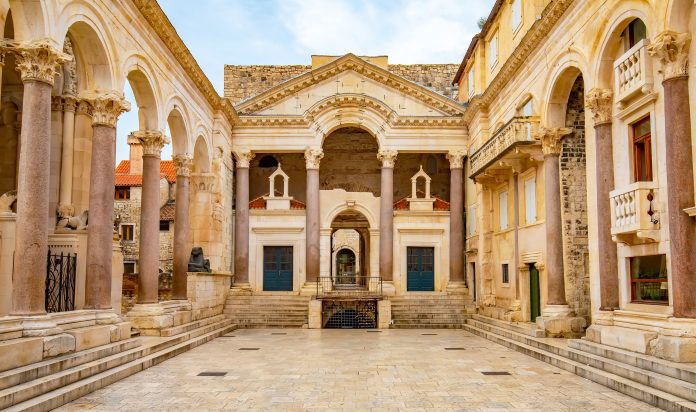When Emperor Diocletian made the unprecedented decision to voluntarily leave the throne of Rome, he didn’t fade into obscurity. Instead, he returned to the shores of his childhood – to Dalmatia, where the sea was clearer, the winds gentler, and the stones older than memory.
But he didn’t come to rest. He came to build. And what he built would never die.
He chose a bay just south of Salona, the Roman capital of Dalmatia, and ordered the construction of a vast seaside palace. A fortress-temple-villa hybrid, designed not for future emperors, but for a man who had ruled the world and now wanted to retire among gods and sea foam.
A Palace, Then a City
Construction began around 295 AD. The palace was no mere pleasure house. It was a vision carved in Brač limestone, reinforced with Egyptian sphinxes, Greek marble, and the finest Roman engineering.
It was divided into two halves:
- The southern section, open to the sea, held the imperial apartments and temples.
- The northern half housed soldiers, servants, and storerooms.
Each of the four gates had a name:
- The Golden Gate faced the land and symbolized imperial power.
- The Silver Gate opened toward Salona.
- The Iron Gate led to the mountains.
- The Bronze Gate, closest to the sea, served as a secretive imperial entrance.
Diocletian died within these walls. But he left behind more than marble. He left behind a structure that would never become a ruin.
The Living Palace
As Salona fell in the 7th century, refugees poured into the palace for protection. They didn’t just seek shelter — they made it home.
They bricked up arches, turned corridors into alleys, temples into churches, and mausoleums into cathedrals. And so, Diocletian’s mausoleum became the Cathedral of Saint Domnius, now considered the oldest Catholic cathedral still in use in the same structure.
No other palace in the world has undergone such a transformation: from imperial residence to living urban heart.
Today, more than 3,000 people still live inside the palace. Washing hangs between Roman pillars. Cafés nestle in ancient courtyards. Cellars beneath the Peristyle echo with both footsteps and festival drums.
A Story in Every Stone
Walk Split with eyes open, and the past speaks softly:
- In the Peristyle, emperors were worshipped. Today, musicians play beside ancient columns as tourists sip espresso.
- In Vestibul, once the entrance to the emperor’s private quarters, the circular echo of a capella singers lifts upward like incense.
- Climb the bell tower of Saint Domnius, and you rise above centuries — with views from Roman foundations to medieval rooftops to modern ferries crossing the Adriatic.
- Visit the Cellars, which once supported the emperor’s quarters. Forgotten for centuries, they are now restored and open, revealing the genius of Roman engineering.
- The Temple of Jupiter, repurposed into a baptistry, still guards its ancient bronze doors.
- Step into Papalić Palace, and enter a noble 15th-century home that whispers of Venetian rule.
Beyond the Palace Walls
Split grew outward like the rings of a tree. Every century left a layer:
- Pjaca (People’s Square) became the medieval and Renaissance heart of the city.
- The Prokurative, built in the 19th century, reflect the influence of Venetian and Austro-Hungarian rule.
- The Riva, the waterfront promenade, transformed from a defensive Roman wall into a place of coffee, conversation, and sunsets.
- Just a short walk away lies Marjan Hill, the city’s green lungs, sacred since pre-Christian times. Climb it, and you see the whole city — not as a skyline, but as a storyline.
Split is Not a Ruin
Unlike many ancient sites, Split is not an echo. It is a conversation between past and present.
You can feel it in the way locals touch the walls as they pass. In the way children play soccer beside 4th-century columns. In the smell of grilled fish rising beside Roman stone.
Split doesn’t ask you to observe. It asks you to enter.
If You Visit
- Take time at the Golden Gate — not just for photos, but to stand where emperors once passed.
- Wander the Green Market outside the palace, where trade has continued, in one form or another, for 1700 years.
- Visit Galerija Meštrović, where Croatia’s greatest sculptor speaks in marble, not unlike the Romans before him.
- Sail to Veli Varoš, a once-poor neighborhood now rich in charm and character.
Conclusion
Split was built for one man. It became home to thousands. It began as a fortress. It became a city. It was once the end of a journey. Now it is the beginning of many.
Come not just to see the palace — come to hear its heartbeat. Because in Split, every stone has something left to say.

